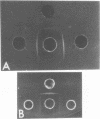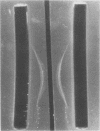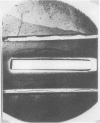Abstract
Sixty-nine strains of Clostridium perfringens of different toxigenic types were investigated for enterotoxin production. Enterotoxin was definitively detected only in strains of types A and C. This is the first report where enterotoxin production has been demonstrated in a toxigenic type other than type A. The exterotoxin-positive type C strains were isolated from cases of enteritis necroticans ("pig bel+) in New Guinea. The major enterotoxin from type C showed a reaction of complete identity with enterotoxin from type A in immunodiffusion using anti-enterotoxin serum prepared against the latter; it induced erythema when injected intradermally into depilated guinea pigs and caused fluid accumulation in the rabbit ileal loop. The results indicate that the major enterotoxin from type C was serologically and biologically similar to enterotoxin from type A. In some C was serologically and biologically similar to enterotoxin from type A. In some type C strains, an enterotoxin was detected that showed a reaction of partial serological identity. Spore coat proteins were extracted from 14-strains by alkaline dithiothreitol, and the extracts were assayed for enterotoxin-like spore protein. Enterotoxin could be extracted from type A and type C spores, and all positive strains showed a reaction of complete identity in immunodiffusion with enterotoxin obtained from cell extracts of type A. Disc immunoelectrophoresis demonstrated that two distinct components that reacted serologically with anti-enterotoxin serum were present in both the cell extract and in extracted spore protein from one type C strain. These distinct components differed in molecular weight.
Full text
PDF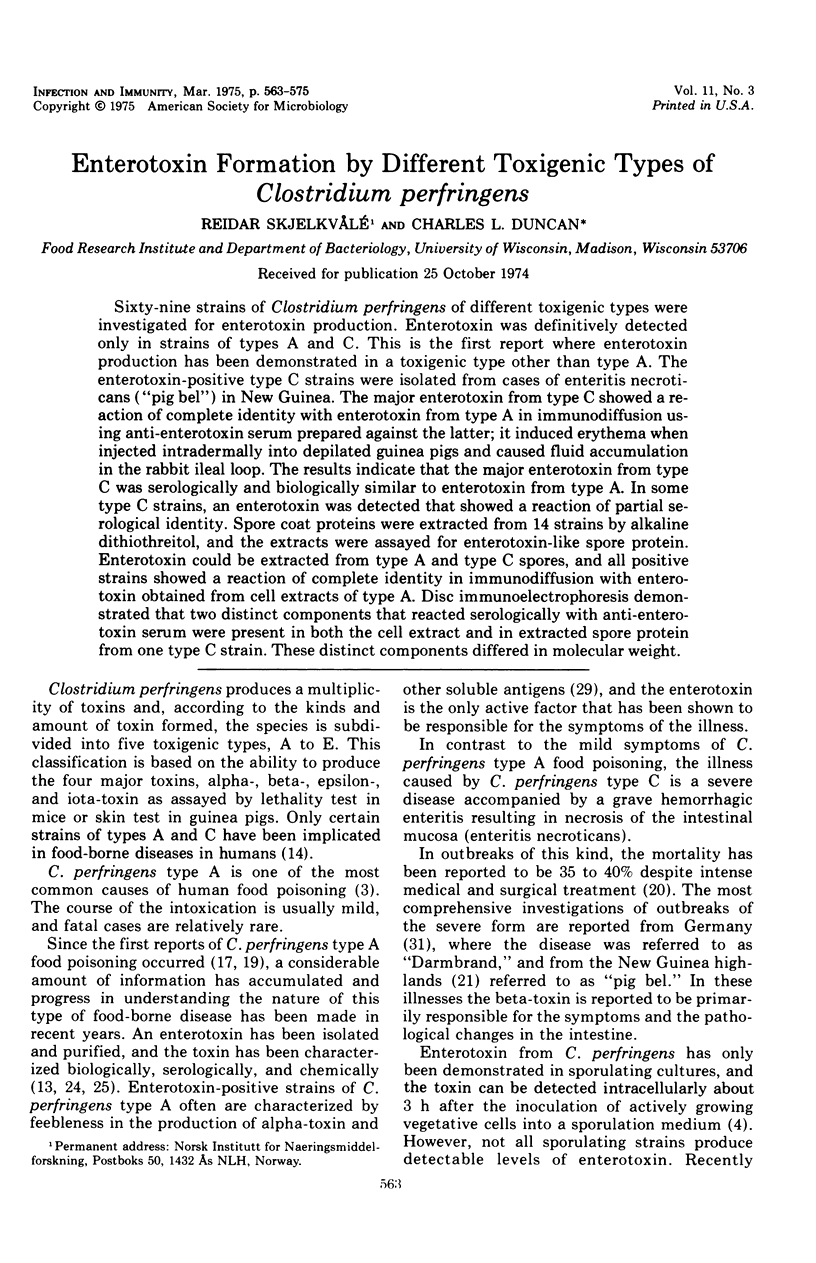
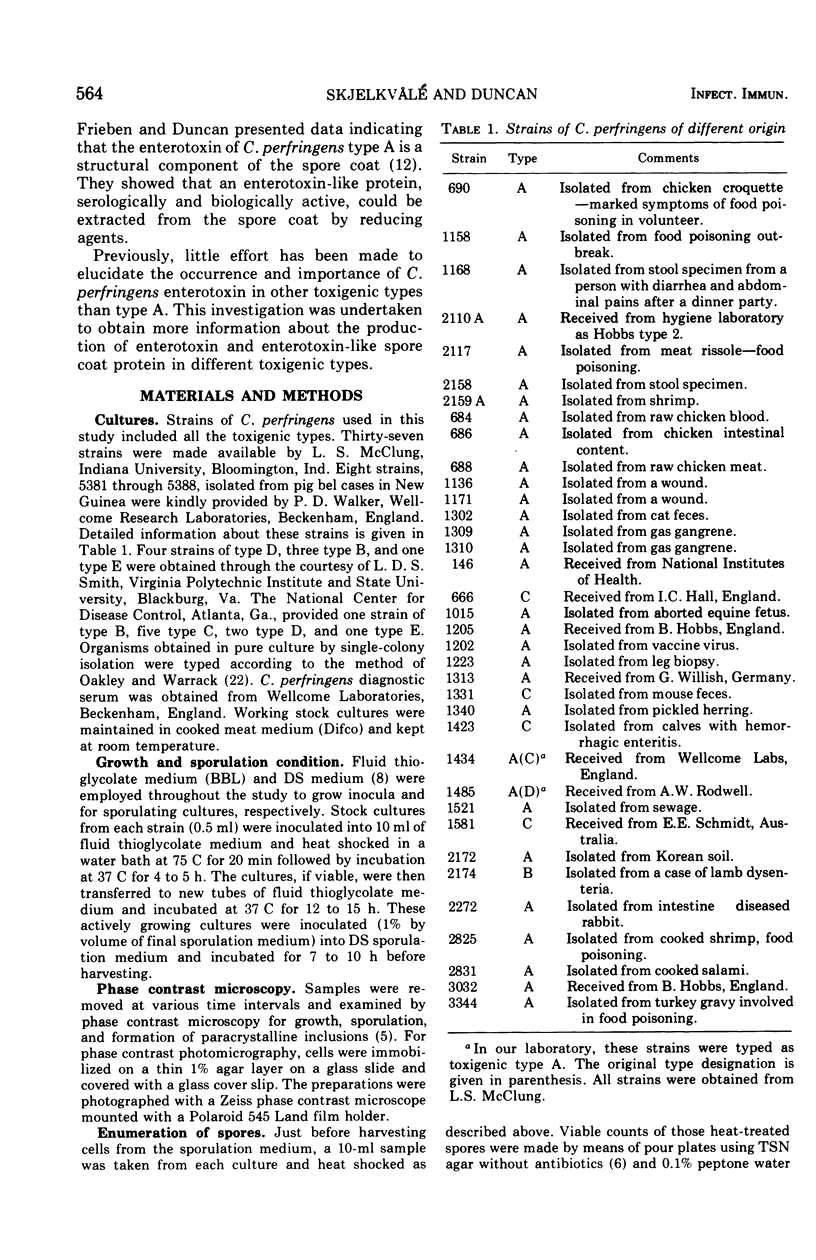
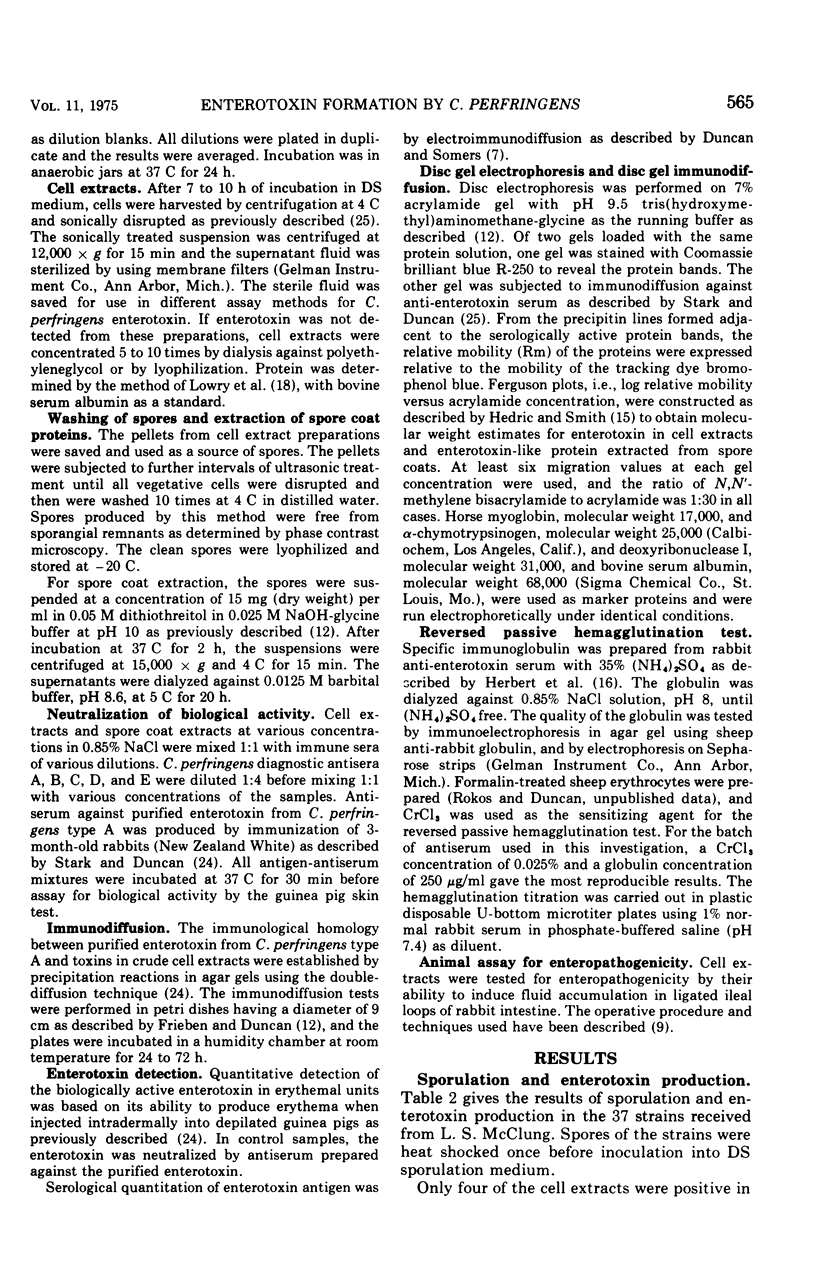
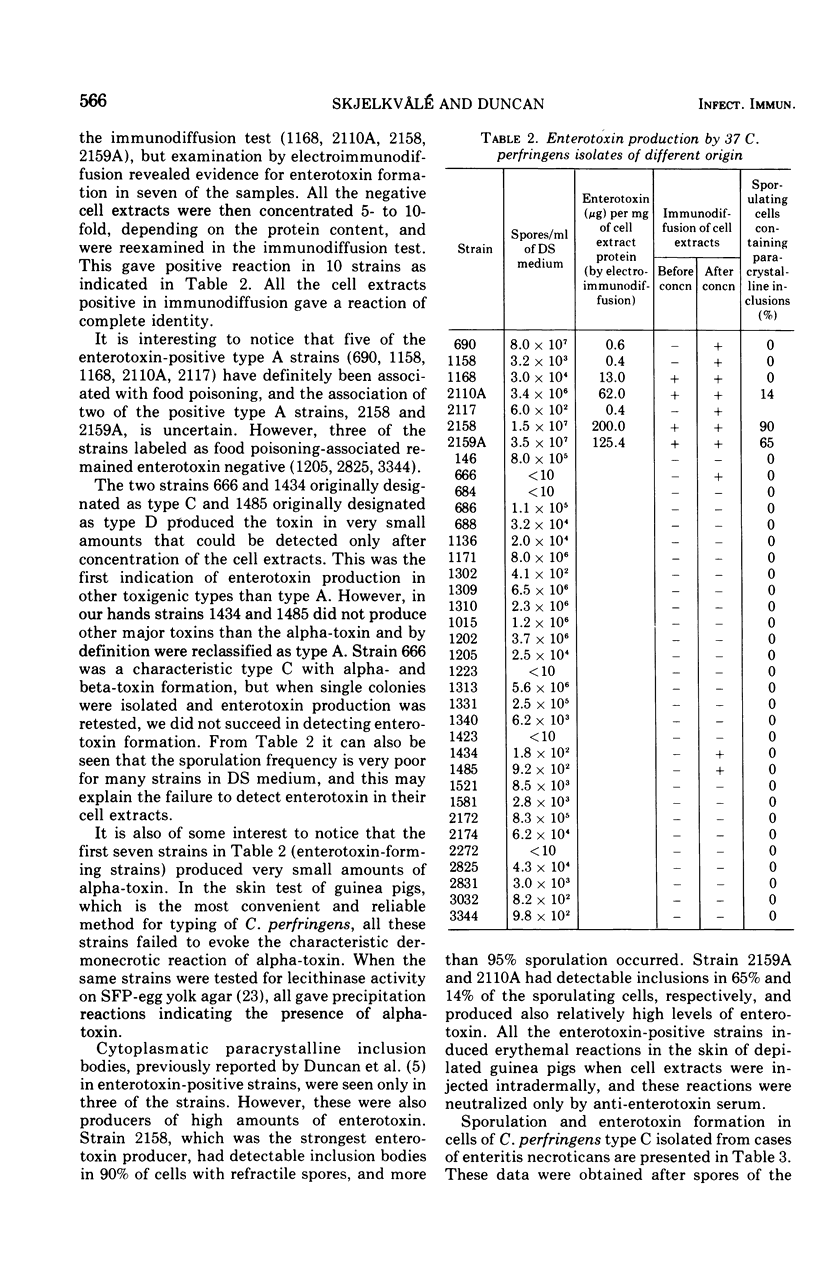

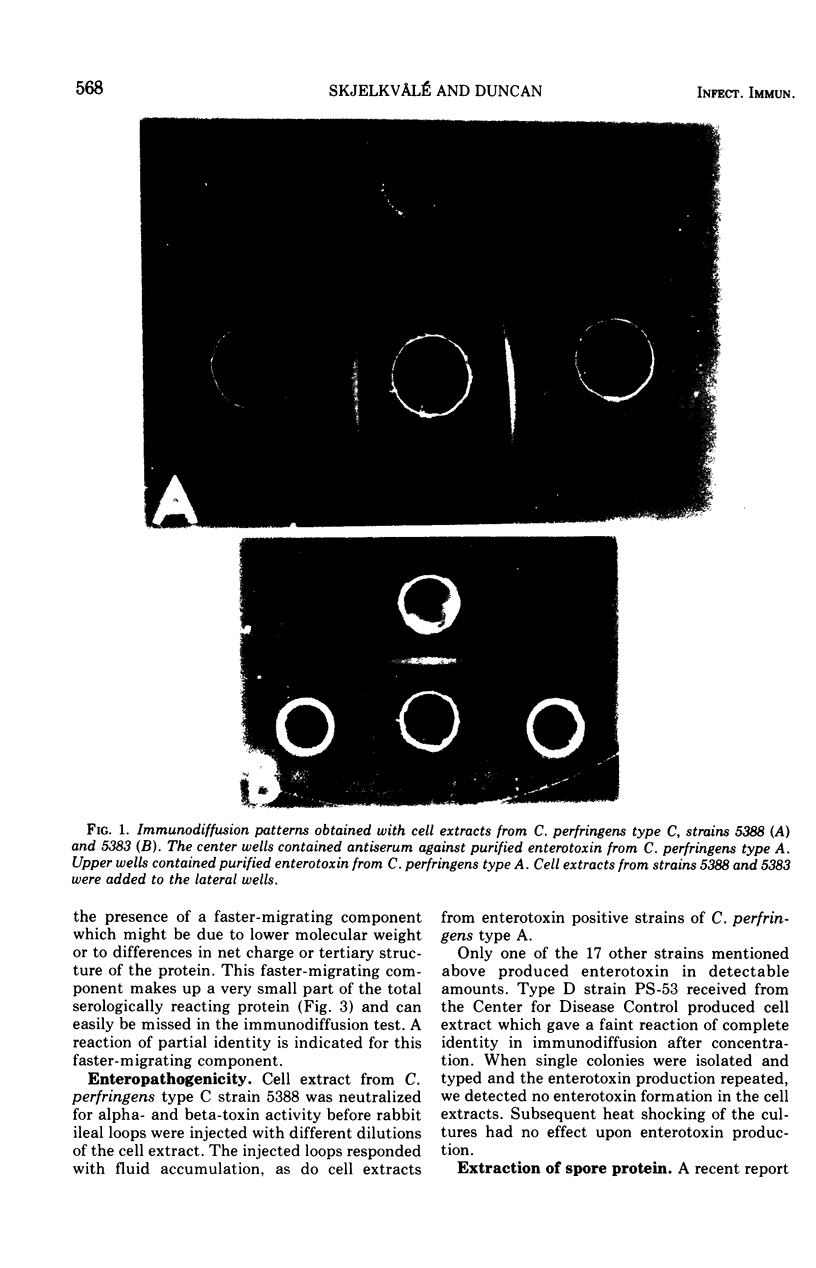
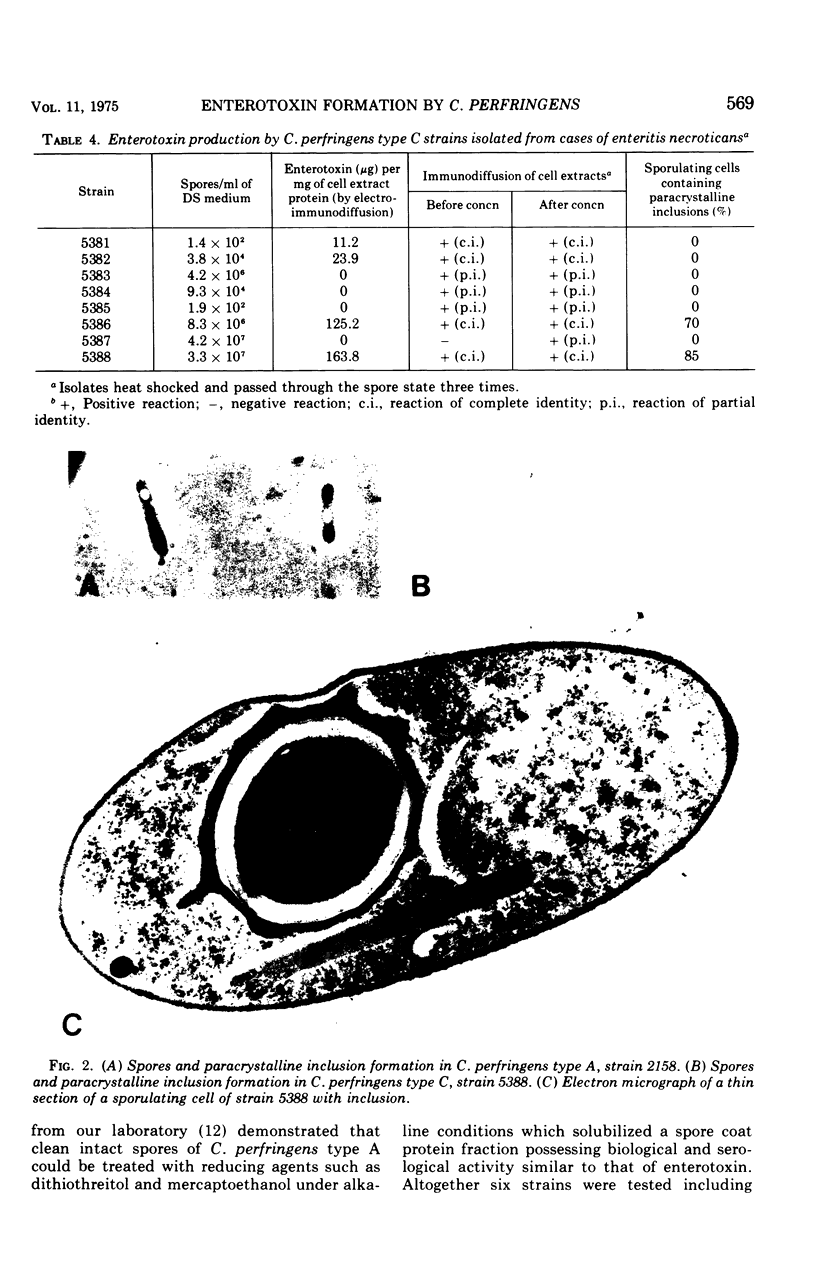
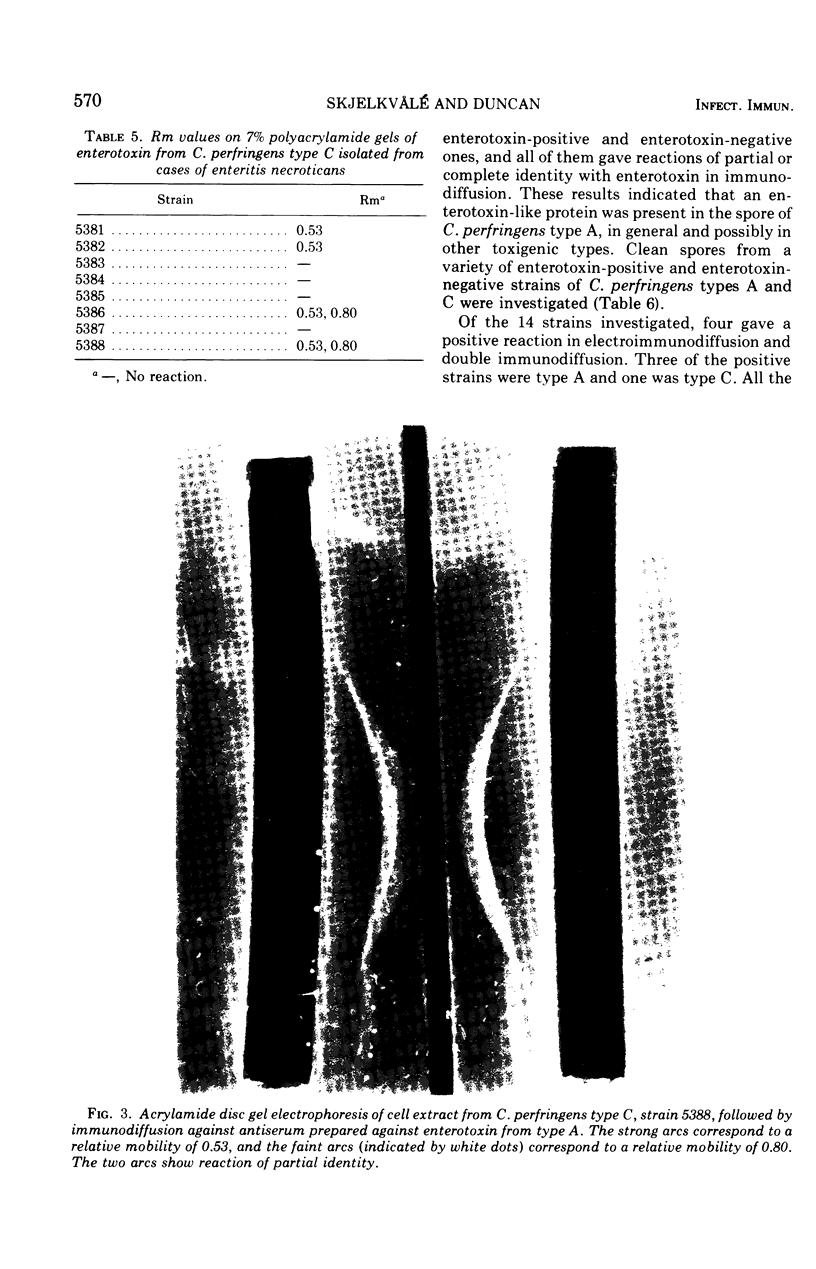
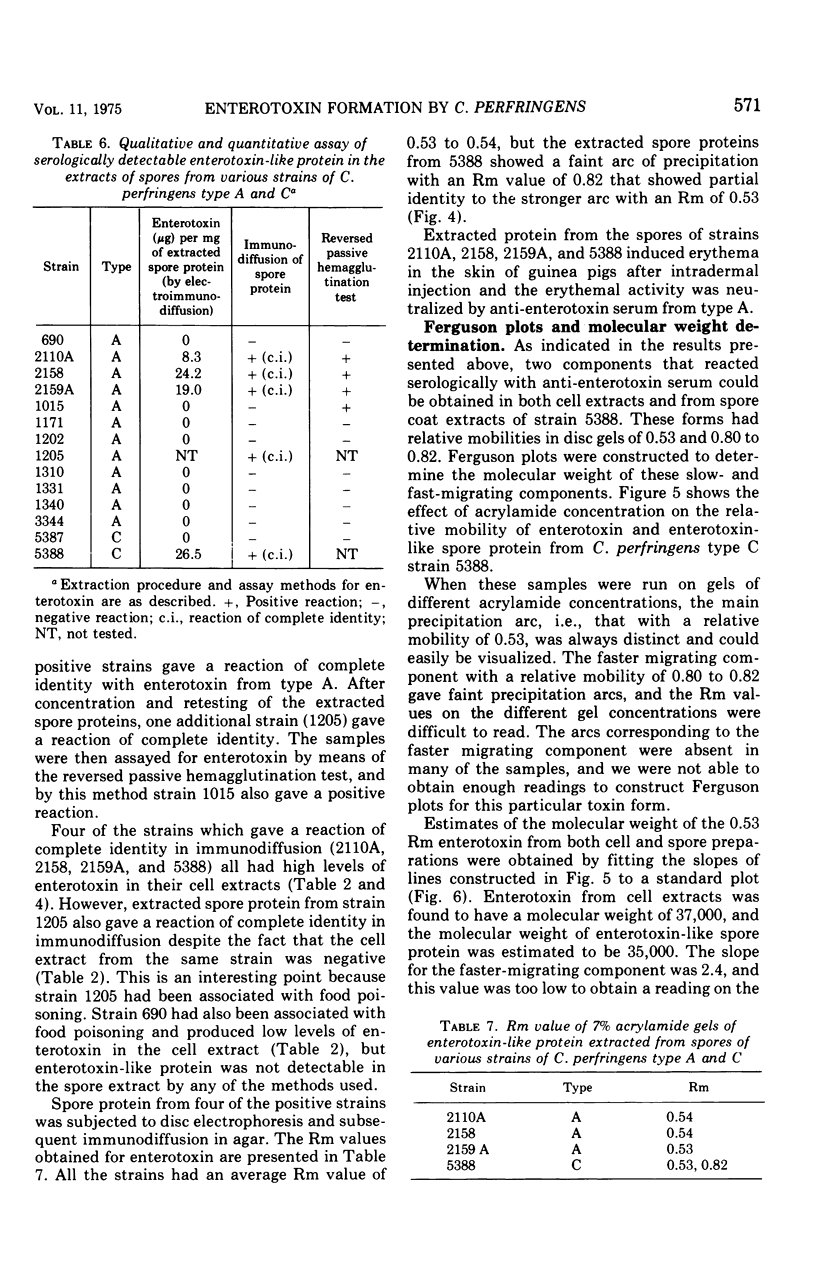
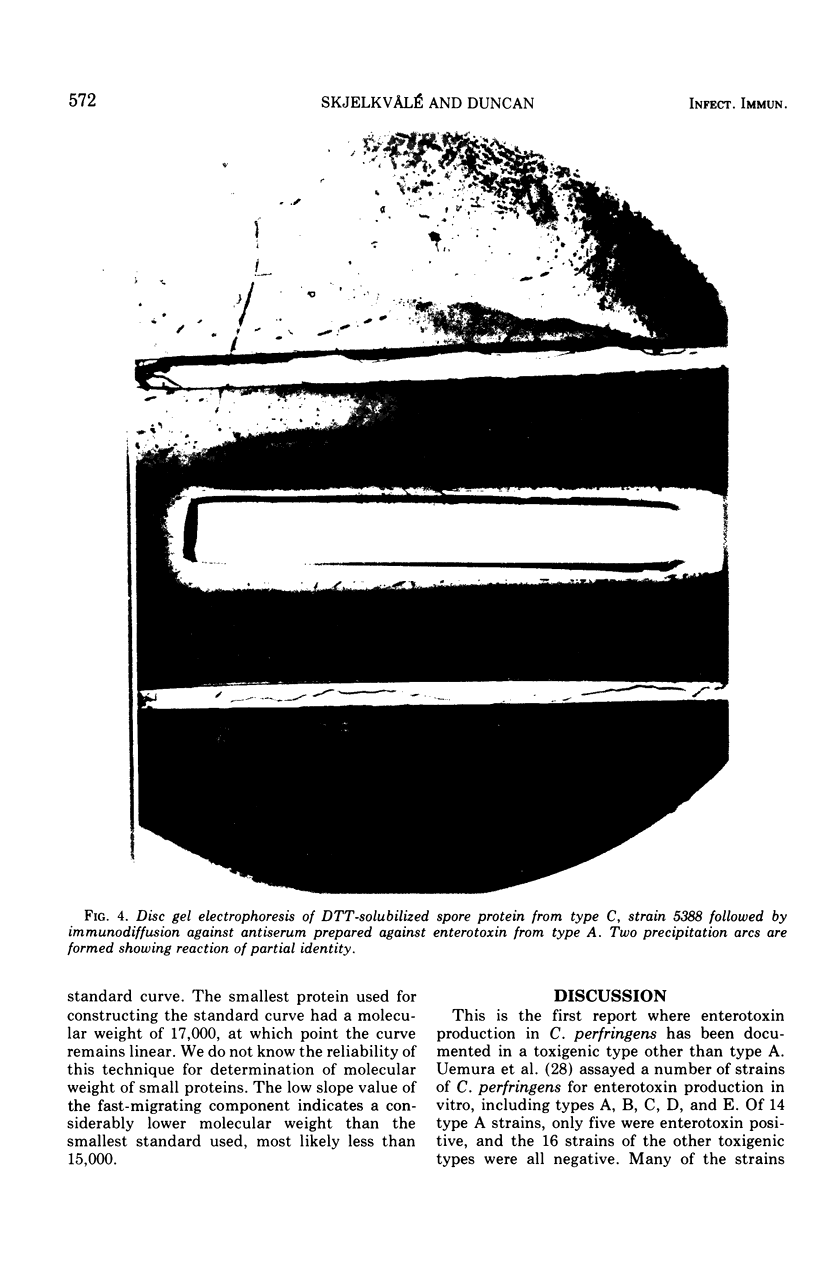
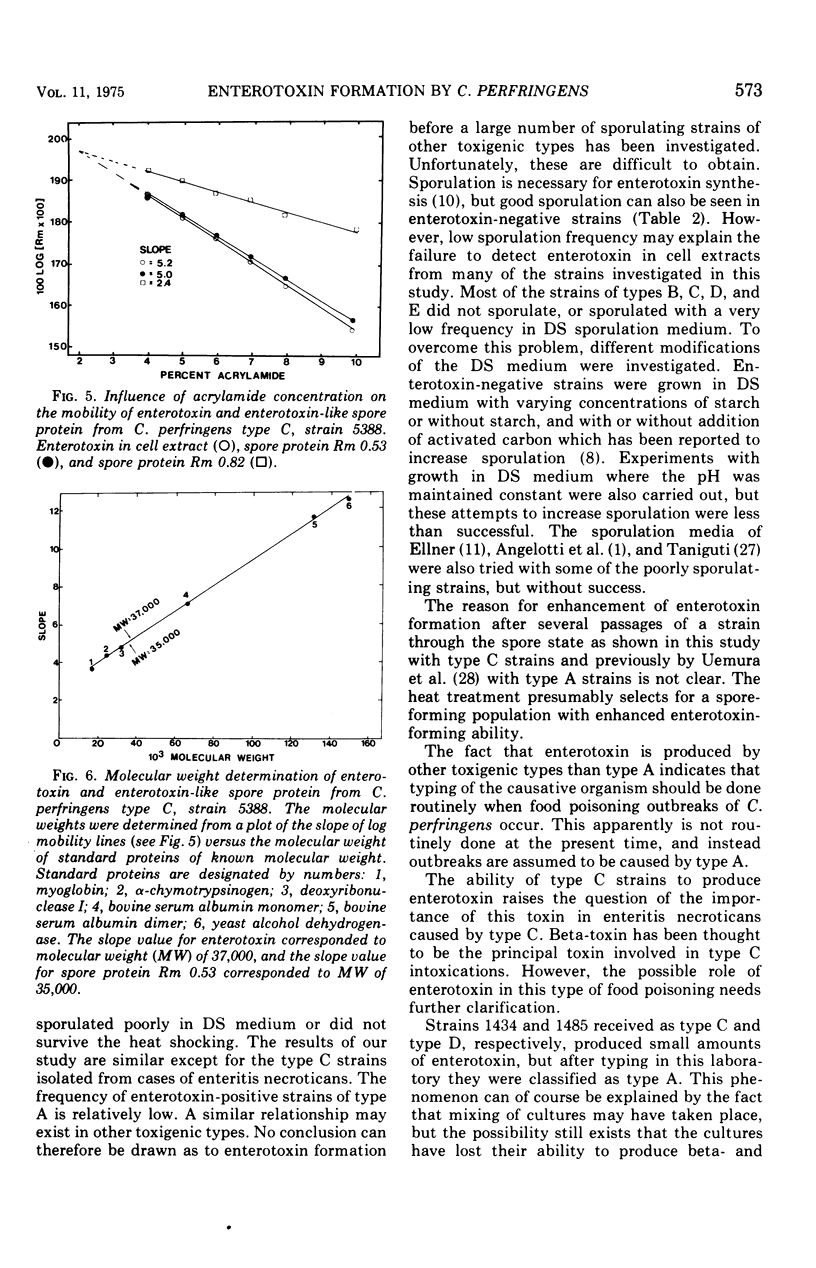
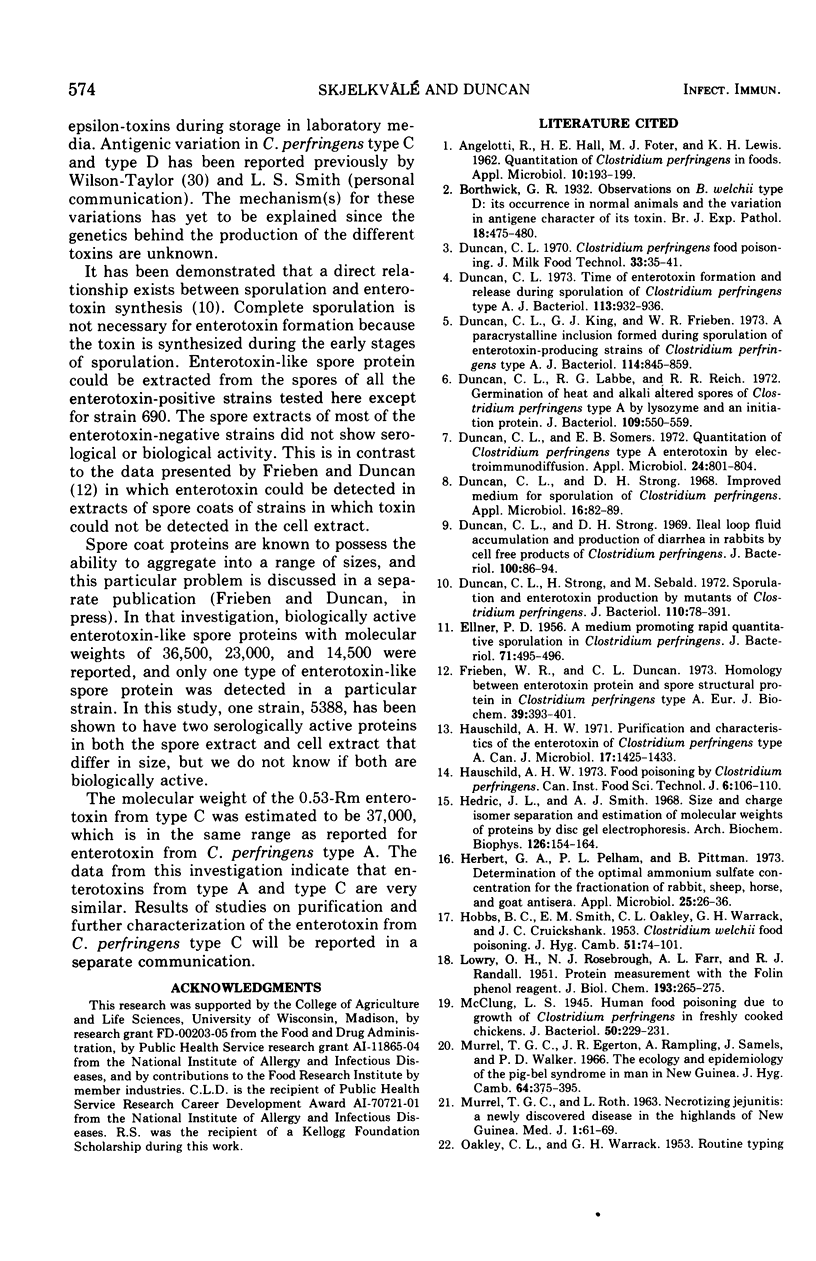
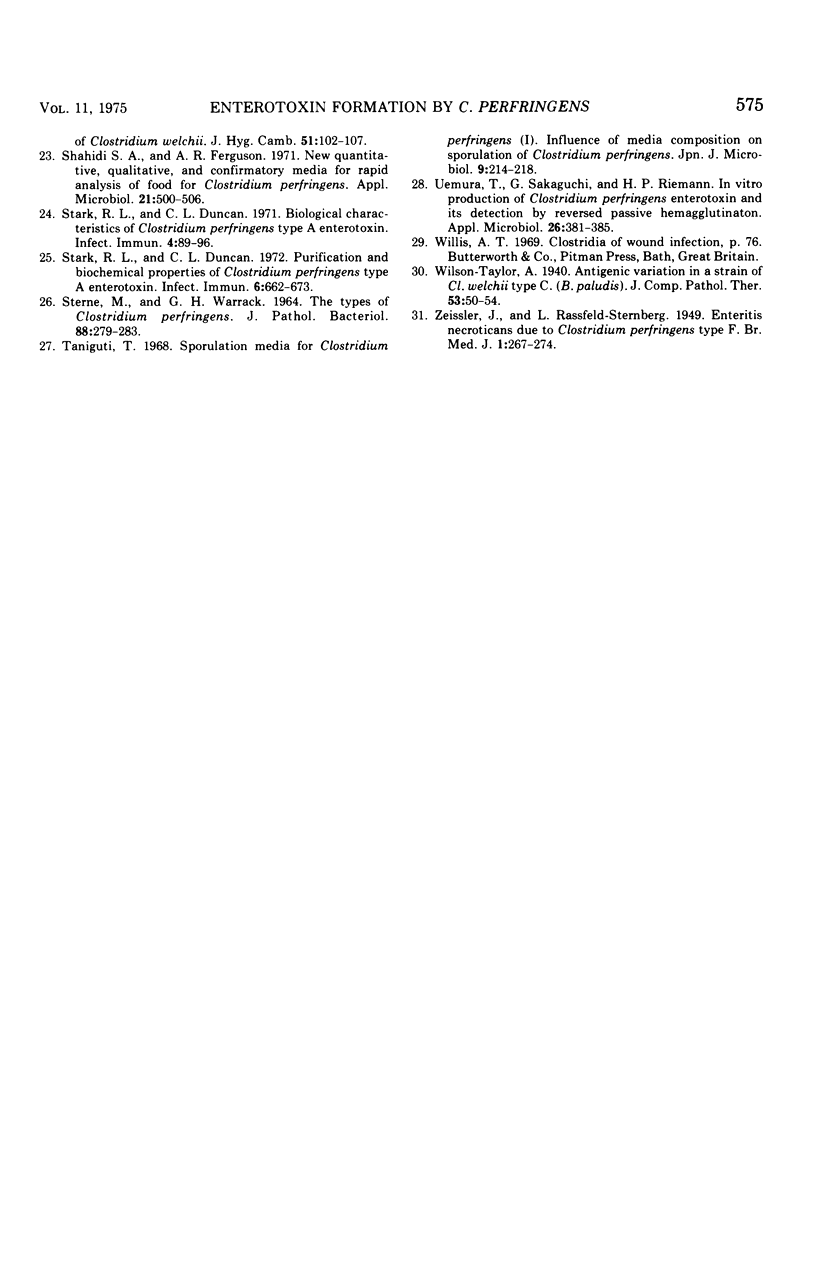
Images in this article
Selected References
These references are in PubMed. This may not be the complete list of references from this article.
- ANGELOTTI R., HALL H. E., FOTER M. J., LEWIS K. H. Quantitation of Clostridium perfringens in foods. Appl Microbiol. 1962 May;10:193–199. doi: 10.1128/am.10.3.193-199.1962. [DOI] [PMC free article] [PubMed] [Google Scholar]
- Duncan C. L., King G. J., Frieben W. R. A paracrystalline inclusion formed during sporulation of enterotoxin-producing strains of Clostridium perfringens type A. J Bacteriol. 1973 May;114(2):845–859. doi: 10.1128/jb.114.2.845-859.1973. [DOI] [PMC free article] [PubMed] [Google Scholar]
- Duncan C. L., Labbe R. G., Reich R. R. Germination of heat- and alkali-altered spores of Clostridium perfringens type A by lysozyme and an initiation protein. J Bacteriol. 1972 Feb;109(2):550–559. doi: 10.1128/jb.109.2.550-559.1972. [DOI] [PMC free article] [PubMed] [Google Scholar]
- Duncan C. L., Somers E. B. Quantitation of Clostridium perfringens type A enterotoxin by electroimmunodiffusion. Appl Microbiol. 1972 Nov;24(5):801–804. doi: 10.1128/am.24.5.801-804.1972. [DOI] [PMC free article] [PubMed] [Google Scholar]
- Duncan C. L., Strong D. H. Ileal loop fluid accumulation and production of diarrhea in rabbits by cell-free products of Clostridium perfringens. J Bacteriol. 1969 Oct;100(1):86–94. doi: 10.1128/jb.100.1.86-94.1969. [DOI] [PMC free article] [PubMed] [Google Scholar]
- Duncan C. L., Strong D. H. Improved medium for sporulation of Clostridium perfringens. Appl Microbiol. 1968 Jan;16(1):82–89. doi: 10.1128/am.16.1.82-89.1968. [DOI] [PMC free article] [PubMed] [Google Scholar]
- Duncan C. L., Strong D. H., Sebald M. Sporulation and enterotoxin production by mutants of Clostridium perfringens. J Bacteriol. 1972 Apr;110(1):378–391. doi: 10.1128/jb.110.1.378-391.1972. [DOI] [PMC free article] [PubMed] [Google Scholar]
- Duncan C. L. Time of enterotoxin formation and release during sporulation of Clostridium perfringens type A. J Bacteriol. 1973 Feb;113(2):932–936. doi: 10.1128/jb.113.2.932-936.1973. [DOI] [PMC free article] [PubMed] [Google Scholar]
- ELLNER P. D. A medium promoting rapid quantitative sporulation in Clostridium perfringens. J Bacteriol. 1956 Apr;71(4):495–496. doi: 10.1128/jb.71.4.495-496.1956. [DOI] [PMC free article] [PubMed] [Google Scholar]
- Frieben W. R., Duncan C. L. Homology between enterotoxin protein and spore structural protein in Clostridium perfringens type A. Eur J Biochem. 1973 Nov 15;39(2):393–401. doi: 10.1111/j.1432-1033.1973.tb03137.x. [DOI] [PubMed] [Google Scholar]
- HOBBS B. C., SMITH M. E., OAKLEY C. L., WARRACK G. H., CRUICKSHANK J. C. Clostridium welchii food poisoning. J Hyg (Lond) 1953 Mar;51(1):75–101. doi: 10.1017/s0022172400015515. [DOI] [PMC free article] [PubMed] [Google Scholar]
- Hauschild A. H., Hilsheimer R. Purification and characteristics of the enterotoxin of Clostridium perfringens type A. Can J Microbiol. 1971 Nov;17(11):1425–1433. doi: 10.1139/m71-227. [DOI] [PubMed] [Google Scholar]
- Hebert G. A., Pelham P. L., Pittman B. Determination of the optimal ammonium sulfate concentration for the fractionation of rabbit, sheep, horse, and goat antisera. Appl Microbiol. 1973 Jan;25(1):26–36. doi: 10.1128/am.25.1.26-36.1973. [DOI] [PMC free article] [PubMed] [Google Scholar]
- LOWRY O. H., ROSEBROUGH N. J., FARR A. L., RANDALL R. J. Protein measurement with the Folin phenol reagent. J Biol Chem. 1951 Nov;193(1):265–275. [PubMed] [Google Scholar]
- MURRELL T. G., ROTH L. Necrotizing jejunitis: a newly discovered disease in the highlands of New Guinea. Med J Aust. 1963 Jan 19;50(1):61–69. doi: 10.5694/j.1326-5377.1963.tb27120.x. [DOI] [PubMed] [Google Scholar]
- McClung L. S. Human Food Poisoning Due to Growth of Clostridium perfringens (C. welchii) in Freshly Cooked Chicken: Preliminary Note. J Bacteriol. 1945 Aug;50(2):229–231. [PMC free article] [PubMed] [Google Scholar]
- Murrell T. G., Egerton J. R., Rampling A., Samels J., Walker P. D. The ecology and epidemiology of the pig-bel syndrome in man in New Guinea. J Hyg (Lond) 1966 Sep;64(3):375–396. doi: 10.1017/s0022172400040663. [DOI] [PMC free article] [PubMed] [Google Scholar]
- OAKLEY C. L., WARRACK G. H. Routine typing of Clostridium welchii. J Hyg (Lond) 1953 Mar;51(1):102–107. doi: 10.1017/s0022172400015527. [DOI] [PMC free article] [PubMed] [Google Scholar]
- STERNE M., WARRACK G. H. THE TYPES OF CLOSTRIDIUM PERFRINGENS. J Pathol Bacteriol. 1964 Jul;88:279–283. [PubMed] [Google Scholar]
- Shahidi S. A., Ferguson A. R. New quantitative, qualitative, and confirmatory media for rapid analysis of food for Clostridium perfringens. Appl Microbiol. 1971 Mar;21(3):500–506. doi: 10.1128/am.21.3.500-506.1971. [DOI] [PMC free article] [PubMed] [Google Scholar]
- Stark R. L., Duncan C. L. Biological characteristics of Clostridium perfringens type A enterotoxin. Infect Immun. 1971 Aug;4(2):89–96. doi: 10.1128/iai.4.2.89-96.1971. [DOI] [PMC free article] [PubMed] [Google Scholar]
- Stark R. L., Duncan C. L. Purification and biochemical properties of Clostridium perfringens type A enterotoxin. Infect Immun. 1972 Nov;6(5):662–673. doi: 10.1128/iai.6.5.662-673.1972. [DOI] [PMC free article] [PubMed] [Google Scholar]
- Uemura T., Sakaguchi G., Riemann H. P. In vitro production of Clostridium perfringens enterotoxin and its detection by reversed passive hemagglutination. Appl Microbiol. 1973 Sep;26(3):381–385. doi: 10.1128/am.26.3.381-385.1973. [DOI] [PMC free article] [PubMed] [Google Scholar]
- ZEISSLER J., RASSFELD-STERNBERG L. Enteritis necroticans due to Clostridium welchii type F. Br Med J. 1949 Feb 12;1(4597):267–269. doi: 10.1136/bmj.1.4597.267. [DOI] [PMC free article] [PubMed] [Google Scholar]



